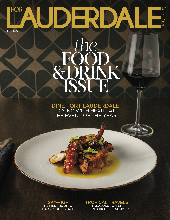About the same time city pioneer Frank Stranahan was setting up shop at his trading post on the New River, three miles north another lone white settler was farming on the bank of the Middle River. A third settler, a bean farmer named Thomas Whidby, was operating another mile or so north in what is now Oakland Park.
The man in the middle was William C. Collier, who arrived in 1895. Collier discovered that the nonwhite residents of the area – the Seminoles – were fond of the fruit coming from his orange grove.
In fact they stopped by so often that they came up with a name for him – “Colo,” short for Collier. Soon after, they attached his location: “hatchee,” or river.
“Collier at the River,” most local historians believe, is the origin of Colohatchee, an area which for a time would occupy a special place in the history of greater Fort Lauderdale. But most traces of it are now gone, with the exception of a Wilton Manors park carrying the name.
Yet in its heyday, the swath of land called Colohatchee stretched from where Fort Lauderdale High School now stands to Commercial Boulevard on the north and Powerline Road on the west. And it produced enough winter vegetables to merit a train station with its name. Even Frank Stranahan bought land there.
According to the Wilton Manors Historical Society, there were two other products being shipped out of Colohatchee. One came from a meat-packing plant just across the north fork of the Middle River, in what is now Oakland Park. The other is not usually mentioned in the history of Florida produce.
But the historical society found a reference in a 1907 issue of American Beekeeper Magazine about one O.O. Poppleton. The “Bee King of Florida” produced 16,000 pounds of honey a year from three locations, with 115 hives in Pompano, 97 in Colohatchee and 62 in Key Largo.
All this put Colohatchee on the map. It was remarkable, considering that the 1920 census indicated a population of 50, mostly farmers.
Yet as the wise man said, “time and tide change everything.” According to the historical society, the Florida East Coast Railway archivist today finds no reference to Colohatchee, and “Flagler archives do not have a lot of information about the freight side of the business.”
But the Colohatchee station was certainly there. It is mentioned as early as 1903 in The Official Railway Guide: North American Freight Service Edition. A 1910 plat shows a station labeled Colohatchee Depot. A 1925 plat of Middle River Plaza does the same.
The station is also shown in an illustration in a 1924 Broward County tourism brochure touting the small community. The text describes a hamlet with a small river on each side “where bass and sergeant [fish] play.” The streams “run through most beautiful scenery, with palms and pines overhung with masses of trailing gray moss.”
It also describes the plenteous winter vegetables and fruit shipped out, as well as civil amenities, including a “very active” women’s club.
Nor, according to the brochure, was education overlooked in this farming community. “Free bus transportation is furnished by the school board for the children to the Fort Lauderdale schools, where they enjoy every educational advantage.”
But by 1929 there were no longer references to Colohatchee – the village or the station.
For one thing, a land developer came along and coined a new name for the area. Ned Willingham, who settled here from Georgia, is said to have come up with the name Wilton Manors in the late 1920s – and it stuck. The town of Wilton Manors was incorporated in 1947.
Meanwhile, the physical station not only disappeared from schedules, but also from its spot at NE 24th Street and Dixie Highway. One account says it was relocated to Oakland Park. Historians of that city have found photos of such a station, which later burnt to the ground.
Today, the Seminole name for an orange trader at the river, and a once thriving agricultural area, seems almost dinosauric. Yet you can’t deny it has a certain charm to it, like cool shade on a hot summer’s day.












